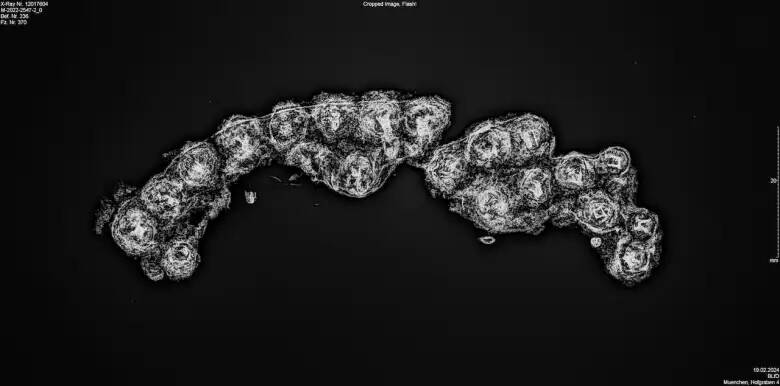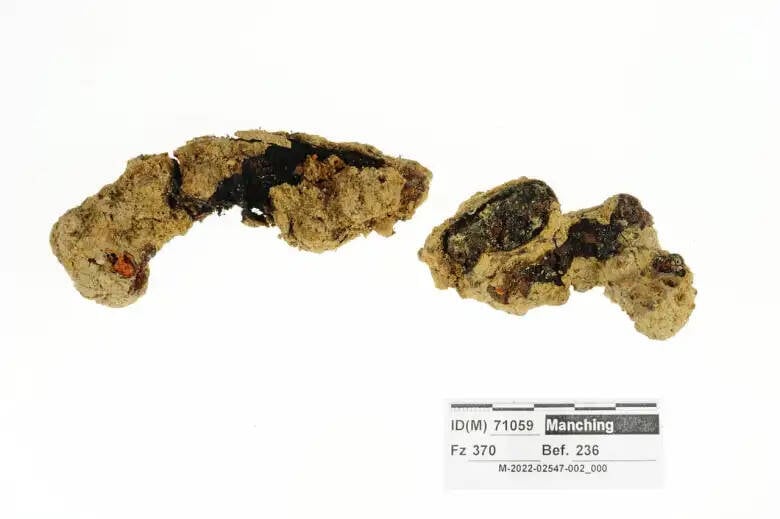Known as caligae, these sandals were worn by Roman soldiers primarily in the first century C.E. and provided traction as they traveled over rough terrain.

Bavarian State Office for Monument ProtectionA recreation of the Roman-era caligae, nailed sandals used to help soldiers cross more easily over difficult terrain.
During a recent excavation of an ancient settlement in Obsertimm, Germany, archaeologists found the remains of a Roman-era sandal dating back 2,000 years.
Although it was initially mistaken for the remains of a sickle, X-ray imaging revealed the artifact to be a leather sandal that had been fitted with iron nails in the sole, likely to provide traction for traversing difficult terrain. This type of sandal was known as a caliga, worn predominantly by Roman soldiers to reduce the likelihood of blisters and prevent slipping, somewhat like modern cleats.
According to officials, while individual nails from Roman shoes are regularly discovered, it is incredibly rare for an intact sole with nails in it to be found in this condition.
The Discovery Of The Ancient Roman Sandal In Germany
In a translated press statement released on June 18, archaeologists from the Bavarian State Office for Monument Protection announced the discovery of the Roman-era caliga, which was found at the bottom of a well at the site of an ancient settlement in Obsertimm, roughly 50 miles north of Munich. The settlement was next to a Roman military fort, dating to between 60 and 130 C.E.
Alongside the caliga, archaeologists found typical Roman ceramics like pottery, scraps of food waste, tools, and costume components. When they found the preserved, slightly corroded remains of some ancient metal, they initially assumed it to be the remains of a sickle. However, X-ray images in the Bavarian State Office for Monument Protection’s workshops revealed it to actually be the sole of a nailed sandal.

Bavarian State Office for Monument ProtectionX-ray images of the recovered caliga sole.
Based on their findings, the sandal was likely worn by an adult, probably a soldier who would have worn the caliga to protect his feet during long marches. These nails would have provided stability and grip over rough terrain, while also preventing blisters and other conditions like trench foot, a painful infection caused by prolonged dampness and coldness.
The Role Of Caligae In The Ancient Roman Military
“So-called caligae were mainly worn by Roman soldiers during the Roman Imperial period,” Amira Adaileh, a consultant at the Bavarian State Office for Monument Protection, said. “The find illustrates the practices, lifestyles, and even the clothing that the Romans brought to Bavaria, which were adopted by the local people.”
The fact that the caliga was found at the bottom of a well likely contributes to its remarkable preservation. In other cases, researchers have come across nails in various states of preservation, but it is uncommon for them to be found still attached to a leather sole.

Bavarian State Office for Monument ProtectionThe preserved remains of the leather sole with nails in it.
By the end of the first century C.E., caligae (which inspired the nickname of the Roman Emperor Caligula) were eventually replaced in the Roman military by a type of closed shoe known as calcei, which provided more warmth and protection. Still, the presence of this caliga sole shows that elements of Roman footwear made their way into Bavarian culture.
“Surprise finds like the shoe sole from Oberstimm repeatedly demonstrate that valuable information is still gathered even after the completion of archaeological excavations,” said Mathias Pfeil of the Bavarian State Office. “This underscores the invaluable work of our restorers.”
After reading about the discovery of this ancient Roman sandal, learn about decimation, the brutal Roman military punishment that massacred 10 percent of a unit. Then, read about the Praetorian Guard, ancient Rome’s elite military squads.





